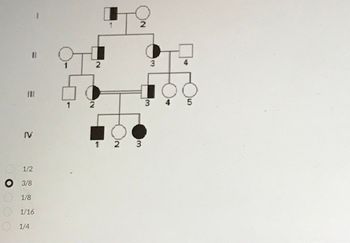
Human Anatomy & Physiology (11th Edition)
11th Edition
ISBN: 9780134580999
Author: Elaine N. Marieb, Katja N. Hoehn
Publisher: PEARSON
expand_more
expand_more
format_list_bulleted
Concept explainers
Topic Video
Question
16) If individuals III-2 and III-3 have an additional child, what are the chances that it'll be an unaffected boy?

Transcribed Image Text:## Pedigree Chart Analysis
The image contains a pedigree chart used to track the inheritance of a specific trait through several generations in a family.
### Explanation of the Pedigree Chart
The pedigree consists of four generations, labeled with Roman numerals I to IV on the left-hand side.
**Legend:**
- Squares represent males.
- Circles represent females.
- Filled shapes indicate individuals expressing the trait.
- Half-filled shapes indicate carriers of the trait (heterozygous individuals).
- Blank shapes indicate individuals not expressing the trait, nor carriers.
### Generations
**Generation I:**
- Individual 1: Male, carrier of the trait (half-filled square).
- Individual 2: Female, does not express the trait (blank circle).
**Generation II:**
- Individual 1: Female, does not express the trait (blank circle).
- Individual 2: Male, expresses the trait (filled square).
- Individual 3: Female, carrier of the trait (half-filled circle).
- Individual 4: Male, does not express the trait (blank square).
**Generation III:**
- Individual 1: Male, does not express the trait (blank square).
- Individual 2: Female, expresses the trait (filled circle).
- Individual 3: Male, carrier of the trait (half-filled square).
- Individual 4: Female, does not express the trait (blank circle).
- Individual 5: Female, does not express the trait (blank circle).
**Generation IV:**
- Individual 1: Male, expresses the trait (filled square).
- Individual 2: Female, does not express the trait (blank circle).
- Individual 3: Male, expresses the trait (filled square).
### Question and Opportunities
Below the pedigree chart, a multiple-choice question is presented, with the question indicated by a black circle:
- Select the correct probability regarding a given trait.
- 1/2
- 3/8 (selected)
- 1/8
- 1/16
- 1/4
This pedigree chart helps in understanding the mode of inheritance of a certain genetic trait within a family, which can be crucial for genetic counseling, risk assessment, and understanding hereditary patterns.
Expert Solution
This question has been solved!
Explore an expertly crafted, step-by-step solution for a thorough understanding of key concepts.
Step by stepSolved in 4 steps with 2 images

Knowledge Booster
Learn more about
Need a deep-dive on the concept behind this application? Look no further. Learn more about this topic, biology and related others by exploring similar questions and additional content below.Similar questions
arrow_back_ios
arrow_forward_ios
Recommended textbooks for you
 Human Anatomy & Physiology (11th Edition)BiologyISBN:9780134580999Author:Elaine N. Marieb, Katja N. HoehnPublisher:PEARSON
Human Anatomy & Physiology (11th Edition)BiologyISBN:9780134580999Author:Elaine N. Marieb, Katja N. HoehnPublisher:PEARSON Biology 2eBiologyISBN:9781947172517Author:Matthew Douglas, Jung Choi, Mary Ann ClarkPublisher:OpenStax
Biology 2eBiologyISBN:9781947172517Author:Matthew Douglas, Jung Choi, Mary Ann ClarkPublisher:OpenStax Anatomy & PhysiologyBiologyISBN:9781259398629Author:McKinley, Michael P., O'loughlin, Valerie Dean, Bidle, Theresa StouterPublisher:Mcgraw Hill Education,
Anatomy & PhysiologyBiologyISBN:9781259398629Author:McKinley, Michael P., O'loughlin, Valerie Dean, Bidle, Theresa StouterPublisher:Mcgraw Hill Education, Molecular Biology of the Cell (Sixth Edition)BiologyISBN:9780815344322Author:Bruce Alberts, Alexander D. Johnson, Julian Lewis, David Morgan, Martin Raff, Keith Roberts, Peter WalterPublisher:W. W. Norton & Company
Molecular Biology of the Cell (Sixth Edition)BiologyISBN:9780815344322Author:Bruce Alberts, Alexander D. Johnson, Julian Lewis, David Morgan, Martin Raff, Keith Roberts, Peter WalterPublisher:W. W. Norton & Company Laboratory Manual For Human Anatomy & PhysiologyBiologyISBN:9781260159363Author:Martin, Terry R., Prentice-craver, CynthiaPublisher:McGraw-Hill Publishing Co.
Laboratory Manual For Human Anatomy & PhysiologyBiologyISBN:9781260159363Author:Martin, Terry R., Prentice-craver, CynthiaPublisher:McGraw-Hill Publishing Co. Inquiry Into Life (16th Edition)BiologyISBN:9781260231700Author:Sylvia S. Mader, Michael WindelspechtPublisher:McGraw Hill Education
Inquiry Into Life (16th Edition)BiologyISBN:9781260231700Author:Sylvia S. Mader, Michael WindelspechtPublisher:McGraw Hill Education

Human Anatomy & Physiology (11th Edition)
Biology
ISBN:9780134580999
Author:Elaine N. Marieb, Katja N. Hoehn
Publisher:PEARSON

Biology 2e
Biology
ISBN:9781947172517
Author:Matthew Douglas, Jung Choi, Mary Ann Clark
Publisher:OpenStax

Anatomy & Physiology
Biology
ISBN:9781259398629
Author:McKinley, Michael P., O'loughlin, Valerie Dean, Bidle, Theresa Stouter
Publisher:Mcgraw Hill Education,

Molecular Biology of the Cell (Sixth Edition)
Biology
ISBN:9780815344322
Author:Bruce Alberts, Alexander D. Johnson, Julian Lewis, David Morgan, Martin Raff, Keith Roberts, Peter Walter
Publisher:W. W. Norton & Company

Laboratory Manual For Human Anatomy & Physiology
Biology
ISBN:9781260159363
Author:Martin, Terry R., Prentice-craver, Cynthia
Publisher:McGraw-Hill Publishing Co.

Inquiry Into Life (16th Edition)
Biology
ISBN:9781260231700
Author:Sylvia S. Mader, Michael Windelspecht
Publisher:McGraw Hill Education